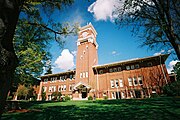Washington State University College of Veterinary Medicine
| Type | Public Veterinary school |
|---|---|
| Established | 1899 |
| Dean | Bryan K. Slinker |
| Location | , , U.S. |
| Website | www |
The Washington State University College of Veterinary Medicine (CVM) is the veterinary school and one of the ten colleges of Washington State University. Established in 1899, it is the sole veterinary school in the state of Washington and one of the oldest in the United States. The college is located at the main campus in Pullman, Washington.
Departments
The College of Veterinary Medicine is organized into three departments, schools and units:[1]
- Department of Veterinary Clinical Science
- Department of Integrative Physiology and Neuroscience
- Department of Veterinary Microbiology and Pathology
- The Paul G. Allen School for Global Animal Health
- The School of Molecular Biosciences
- Center for Reproductive Biology
Accreditation
The college is fully accredited by four key national accrediting agencies:[2]
- The American Veterinary Medical Association Council on Education (AVMA-COE)
- The Association for Assessment and Accreditation of Laboratory Animal Care (AAALAC),
- The American Association of Veterinary Laboratory Diagnosticians (AAVLD),
- The American Animal Hospital Association (AAHA).
Research
The College of Veterinary Medicine has an abundant research that would benefit animal and human well being as well. In the fiscal year of 2006, the CVM had funded with more than $12.5 million in conducting research, that specialized in food-and water-borne diseases, neurobiology, cardiovascular medicine and physiology, immunology and infectious diseases, and microbial genomics and proteomics.[3]

